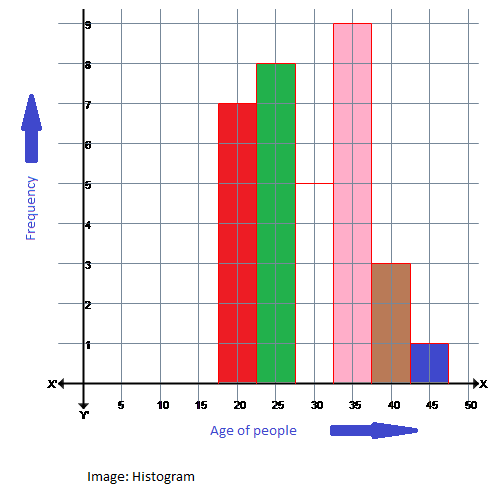
Consider the following statement.
I. Mode can be computed from histogram.
II. Median is not independent of change of scale.
III. Variance independent of change of origin and scale.
Which of these is/are correct?
A. Only I
B. Only II
C. I and II
D. I, II, and II
Answer
217.5k+ views
Hint: First we will draw a histogram to check whether the mode can be found in the histogram. Next from the formula of the median, we will decide whether the second statement is true or not. Similarly, from the formula of the variance, we will decide whether the second statement is true or not.
Formula Used:
The formula for median is $ = l + \dfrac{h}{f}\left( {\dfrac{N}{2} - C} \right)$
The formula of variance is ${\sigma ^2} = \dfrac{{\sum\limits_{i = 1}^N {\left( {{x_i} - \mu } \right)} }}{N}$
Complete step by step solution:

Let's consider the above histogram.
The value that appears most frequently in a data set is called the mode.
From the histogram, we can say that the frequency of the people whose age is 35 is maximum.
So, 35 is the mode of data.
Thus, statement I is correct.
The formula of median is $ = l + \dfrac{h}{f}\left( {\dfrac{N}{2} - C} \right)$
$l \to $ Lower class boundary of median class
$h \to $ Size of the median class interval
$f \to $ Frequency corresponding to median class
$N \to $ Total number of observations
$C \to $ Cumulative frequency preceding median class
The median of a data will be changed if data are changed. Hence the median of data is dependent on the change of scale.
Hence statement II is correct.
The formula of variance is ${\sigma ^2} = \dfrac{{\sum\limits_{i = 1}^N {\left( {{x_i} - \mu } \right)} }}{N}$
${\sigma ^2} \to $ Population variance.
${x_i} \to $ Value of ${i^{th}}$ element.
$\mu \to $ Population mean.
$N \to $ Population size.
The variance of a data will be changed if data are changed. Hence the variance of data is dependent on the change of scale.
Hence statement III is incorrect.
Option ‘C’ is correct
Note: Here Change of scale means the changes of data. An extension of the bar graph is the histogram. A histogram is a type of vertical bar graph in which the bars represent grouped continuous data. The shape of a histogram can tell you a lot about the distribution of the data, as well as provide you with information about the mean, median, and mode of the data set. Students must remember the basic definition related to statistics in order to visualize the mean, median, mode directly from histogram.
Formula Used:
The formula for median is $ = l + \dfrac{h}{f}\left( {\dfrac{N}{2} - C} \right)$
The formula of variance is ${\sigma ^2} = \dfrac{{\sum\limits_{i = 1}^N {\left( {{x_i} - \mu } \right)} }}{N}$
Complete step by step solution:

Let's consider the above histogram.
The value that appears most frequently in a data set is called the mode.
From the histogram, we can say that the frequency of the people whose age is 35 is maximum.
So, 35 is the mode of data.
Thus, statement I is correct.
The formula of median is $ = l + \dfrac{h}{f}\left( {\dfrac{N}{2} - C} \right)$
$l \to $ Lower class boundary of median class
$h \to $ Size of the median class interval
$f \to $ Frequency corresponding to median class
$N \to $ Total number of observations
$C \to $ Cumulative frequency preceding median class
The median of a data will be changed if data are changed. Hence the median of data is dependent on the change of scale.
Hence statement II is correct.
The formula of variance is ${\sigma ^2} = \dfrac{{\sum\limits_{i = 1}^N {\left( {{x_i} - \mu } \right)} }}{N}$
${\sigma ^2} \to $ Population variance.
${x_i} \to $ Value of ${i^{th}}$ element.
$\mu \to $ Population mean.
$N \to $ Population size.
The variance of a data will be changed if data are changed. Hence the variance of data is dependent on the change of scale.
Hence statement III is incorrect.
Option ‘C’ is correct
Note: Here Change of scale means the changes of data. An extension of the bar graph is the histogram. A histogram is a type of vertical bar graph in which the bars represent grouped continuous data. The shape of a histogram can tell you a lot about the distribution of the data, as well as provide you with information about the mean, median, and mode of the data set. Students must remember the basic definition related to statistics in order to visualize the mean, median, mode directly from histogram.
Recently Updated Pages
Area vs Volume: Key Differences Explained for Students

Mutually Exclusive vs Independent Events: Key Differences Explained

Convex and Concave Lenses Explained: Uses, Differences & Diagrams

Coulomb's Law: Definition, Formula, and Examples

De Broglie Equation Explained: Formula, Derivation & Uses

Differentiation in Kinematics: Concepts & Examples Explained

Trending doubts
JEE Main 2026: Application Form Open, Exam Dates, Syllabus, Eligibility & Question Papers

JEE Main 2026 Chapter-Wise Syllabus for Physics, Chemistry and Maths – Download PDF

JEE Main Previous Year Question Paper with Answer Keys and Solutions

Understanding Newton’s Laws of Motion

JEE Main Cut Off 2026 - Expected Qualifying Marks and Percentile Category Wise

Marks vs Percentile JEE Mains 2026: Calculate Percentile Marks

Other Pages
NCERT Solutions For Class 10 Maths Chapter 12 Surface Area And Volume

NCERT Solutions for Class 10 Maths Chapter Chapter 13 Statistics

NCERT Solutions for Class 10 Maths Chapter 11 Areas Related to Circles 2025-26

Pregnancy Week and Due Date Calculator: Find How Far Along You Are

NCERT Solutions for Class 10 Maths Chapter 15 Probability

Complete List of Class 10 Maths Formulas (Chapterwise)




